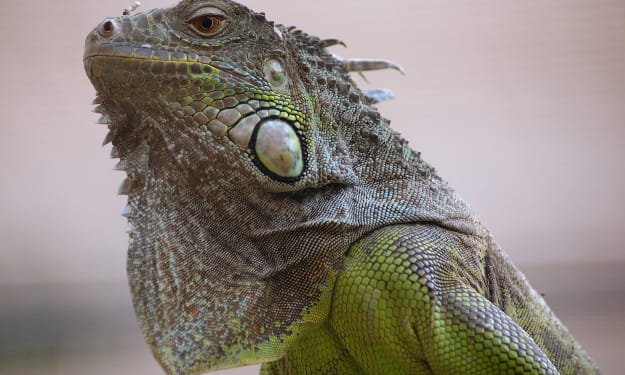Gharials - The Best of the Crocodile Grins!
Errrr... What even is a Gharial anyway?

The first successful breeding of gharials (Gavialis gangeticus) in Europe took place at Protivin Crocodile Zoo in the Czech Repulic this year, an incredible achievement—congratulations! Following this, I decided to dedicate this entry to the urgent plight of the gharial and take this opportunity to nerd out about what are hands down my favourite species of crocodilian.
First and foremost, what is a Gharial? A Gharial is a species of crocodilian that has evolved to specialise in catching and eating fish. Their slender snout means less resistance under water, allowing them to whip their heads quickly through the water to catch even the fastest of fish. The adult males of the species have a bulbous nasal appendage that resembles an earthenware pot that is called a ghara in Hindi. And now you know where they get their name! The males use this ghara to create a buzzing sound during mating season once they’ve matured at around thirteen years of age. This is to attract potential mates to add to their harem.
Despite having the slimmest mouth in the crocodilian world, they are amongst the largest, growing to lengths of up to six meters with males being larger than females. They also have the most teeth averaging at around 116 whilst other species have between 64 and 86.
They are found in Nepal and in Northern India with the largest population residing in the Chambal river. This is where their problems begin. They’ve been rendered extinct in Pakistan, Bangladesh, Bhutan and Myanmar. The populations that are left are extremely fragmented. This means that they are classified as being critically endangered on the IUCN Red List. By 1976 the wild population went from an estimated 10,000 down to less than 200. That’s a 96% drop in numbers within the space of just 60 years.
So, what happened?
Well unfortunately it’s the same story we hear time and time again. They were hunted for their skin and for trophies, their eggs being collected for human consumption, killed by the gill nets popular with fishermen in the area, and they are valued for their various body parts in indigenous medicine. Add to that the construction of dams, barrages, irrigation canals, sand-mining, riparian (river) agriculture, artificial embankments, and both domestic and feral livestock which are the results of the human population explosion. Humans are not only outright killing them, but also severely restricting their habitat. Hussain in 2001 documented 276 irrigation projects in the Chambal alone and these problems aren’t getting any better.
It’s not all bad news though! Conservation attempts started in the 1970s. These first attempts weren’t very successful and this was contributed to the lack of protected areas and by their being released in unsuitable habitats. Nowadays there’s more hope. The Gharial Conservation Alliance are spearheading a multifaceted more political approach to their conservation. The re-introduction programme is still continuing but is now teamed with continuously increasing protected areas.
The other steps to take that the G.C.A. have identified that are essential include:
- Lobbying for political support not just gharial conservation, but the river’s biodiversity conservation in the main states where gharials are present.
- The enforcement of wildlife protection laws.
- An increase in the patrolling activity in gharial protected areas.
- Annual monitoring of surviving populations of gharials.
- The formulation of and implementation of management plans for the protected gharial areas.
- The development of a research programme examining the different areas of the gharial’s biology focussing on finding ways to help them survive the monsoon season where water ‘flushes’ everything out of the rivers.
- Finding other suitable sites for gharials to be released in that can be protected.
- Research focussing on the people living alongside the gharials and finding ways for the two species to cohabit, also attempting to find alternate income for these people so they are less dependent on the river and less likely to come into conflict with the gharials or their food source.
- Developing and implementing awareness programmes both nationally in India and internationally, generating more fund-raising efforts and potential ex-situ breeding populations
To find out more about these efforts, visit the Gharial Conservation Alliance’s page here.
To find out more about Protivin Crocodile Zoo’s gharial hatchlings (and to coo over the adorable babies!) here’s a link to their website.
An amazing in depth look at the problems facing gharials has been documented by Tarun Nair, to see his work click here.
The Gharial’s story is a sad one and one that has resonated with me. I knew Gharials existed and that they were endangered but I wasn’t aware of the extent until I watched a programme following the incredible Rom Whitaker about seven years ago. He is one of the many attempting to bring the gharial back from the brink. I have a soft spot for crocodilians but these guys are my favourite and that I think, is partly due to the fact that there aren’t many people around that has heard of them. It’s not surprising really when you think about it. However you feel about zoos (I’m personally sitting on the fence), they are an excellent way of getting the public involved in an animal’s conservation. How can you care about an animal if you’ve never seen it? If you don’t know it even exists? That to me makes their plight more desperate. If you do want to see one in the flesh, the nearest population are in La Ferme aux Crocodiles in Pierrelatte, France. If you happen to be in the region, go check them out, they have a collection boasting over 400 crocodiles including an incredibly rare albino American Alligator (Alligator mississipiensis) plus many other cool herps!
That’s all from me for now folks! Join the Facebook page to get updates on when the next blog is up (just search for the happy herper) and as always, get in contact if you have anything you think I should be writing about and please share any encounters you may have had and I’ll post them in the gallery (herpetology related preferably…)!
Laura (The Happy Herper)
Hussain, S.A. and Badola, R., 2001. Integrated Conservation planning for Chambal River Basin.
About the Creator
Laura Daykin
Herpetologist in training! Having muddled my way through a degree I'm now counting down the days until I start my MRes in Endagered Species Recovery and Conservation...






Comments
There are no comments for this story
Be the first to respond and start the conversation.